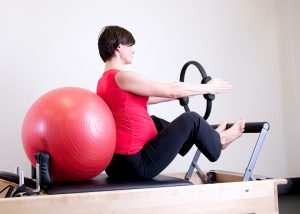
Stability balls are a popular fitness tool used by gym-goers, athletes, and physical therapists alike. They are a versatile, low-cost and effective way to add variation and challenge to any workout. A stability ball, also known as an exercise ball, is a large, inflatable ball that is used for a variety of exercises. The ball is made of thick, durable rubber and is designed to be stable enough to support a person’s weight.
Stability balls can be used for a variety of exercises, from core and balance work to strength training. By using a stability ball, you can target different muscles and increase the difficulty of an exercise. For example, performing a crunch on a stability ball requires your abs to work harder than on the floor, as the ball is less stable and requires you to use your core muscles to hold yourself in place.
Stability balls can be used to improve balance and coordination. Standing on a stability ball while performing an exercise can challenge your balance and coordination while also engaging additional core muscles. For example, if you are doing bicep curls, standing on the ball will require you to use your core muscles to stay balanced and maintain good form.
Stability balls can be used to increase range of motion, flexibility, and mobility. By using a stability ball, you can perform exercises in a way that you wouldn’t be able to do on the floor. For example, a seated chest press on a stability ball will allow you to stretch your chest and arms further than if you were on the floor.
Stability balls can also help strengthen the core muscles. By sitting on a stability ball, you engage your core muscles to maintain balance and proper posture. This helps strengthen your core, which can help improve your posture and reduce back pain.
Stability balls can also be used to improve posture. Sitting on a stability ball forces you to keep your spine in an upright position, thus helping you to maintain good posture.
Stability balls are also widely used in physical therapy, to assist in rehabilitating injuries.
Different Types of Stability Balls
The main types of stability balls include the standard-sized stability ball, mini-stability ball, medicine ball and the fitball. Each type of ball has its own unique properties and advantages that make them better suited for different types of exercises. In this section, we’ll take a closer look at each type of stability ball to help you decide which one is right for you.
Standard-sized stability ball
The standard-sized stability ball is the most widely used type of stability ball and is the one most people are familiar with. Standard-sized stability balls are typically 55 cm to 75 cm in diameter and are made of vinyl, rubber or plastic. These balls are designed to support a range of body weights, from approximately 70 to 300 pounds. Standard-sized stability balls provide an unstable surface and are great for exercises that require you to engage your core, balance and stability. These balls are also great for stretching, yoga and Pilates exercises.
Mini-stability ball
The mini-stability ball is a smaller version of the standard-sized stability ball. These balls are typically 45 cm to 55 cm in diameter and are made of latex or rubber. Mini-stability balls provide a more challenging surface than the standard-sized ball and can be used for exercises that require greater stability and control. Mini-stability balls are great for abdominal exercises, leg extensions and other exercises that need more focus on core stability.
Medicine ball
Medicine balls are weight-filled balls that come in a variety of sizes and weights. Medicine balls are most often used for strength and conditioning exercises, such as overhead throws and squats. Medicine balls are designed to be thrown and caught and are often used in pairs to increase the level of difficulty. Medicine balls can also be used for balance and stability exercises.
Fitball
Fitballs are the largest type of stability ball and are usually 90 cm to 125 cm in diameter. Fitballs are made of heavy-duty vinyl and are designed to hold more weight than other types of stability balls. Fitballs are great for exercises that require a high level of balance and stability, such as yoga and Pilates. Fitballs are also great for stretching and rehabilitation exercises.
No matter which type of stability ball you choose, they all offer a great workout and can be used to target specific muscle groups, improve balance, coordination and stability, and reduce the risk of injury. So, the next time you’re looking for a challenging and versatile form of exercise, consider incorporating a stability ball into your workout routine!

Here’s How To Do A Simple Workout Using A Stability Ball
First, start by standing tall behind the ball. Position the ball between your feet, a few inches behind your heels. Keep your arms extended in front of you and brace your core. Squat down, lowering the ball toward you and keeping your chest up and spine tall. As you come up, press your feet into the ball and lift your arms overhead.
Next, sit on the ball and walk your feet out in front of you until your hips are over the ball. Your arms should be extended in front of you and your core should be engaged. Make sure your feet are planted firmly on the ground. From here, you can do a variety of exercises including chest presses, triceps extensions, crunches, etc.
Also, you can do some balance exercises with the ball. Start by standing behind the ball and gripping the sides. Keep your core engaged and try to balance on the ball. As you get comfortable with the motion, try lifting one foot off the ground and then switch sides.
Here is a useful video on more stability ball exercises: